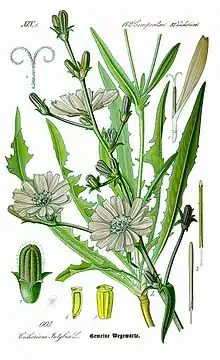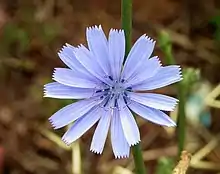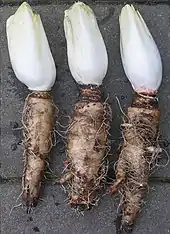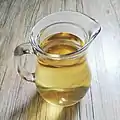Chicory
Common chicory (Cichorium intybus)[4] is a somewhat woody, perennial herbaceous plant of the family Asteraceae, usually with bright blue flowers, rarely white or pink. Native to the Old World, it has been introduced to North America and Australia. Many varieties are cultivated for salad leaves, chicons (blanched buds), or roots (var. sativum), which are baked, ground, and used as a coffee substitute and food additive. In the 21st century, inulin, an extract from chicory root, has been used in food manufacturing as a sweetener and source of dietary fiber.[5]
| Common chicory | |
|---|---|
 | |
| 1885 illustration[1] | |
 | |
| Scientific classification | |
| Kingdom: | Plantae |
| Clade: | Tracheophytes |
| Clade: | Angiosperms |
| Clade: | Eudicots |
| Clade: | Asterids |
| Order: | Asterales |
| Family: | Asteraceae |
| Genus: | Cichorium |
| Species: | C. intybus |
| Binomial name | |
| Cichorium intybus | |
| Synonyms[2][3] | |
|
Synonymy
| |
Chicory is grown as a forage crop for livestock.[6] "Chicory" is also the common name in the United States for curly endive (Cichorium endivia); these two closely related species are often confused.[7]
Description
When flowering, chicory has a tough, grooved, and more or less hairy stem. It can grow to 1.5 metres (5 feet) tall.[8] The leaves are stalked, lanceolate and unlobed; they range from 7.5–32 centimetres (3–12+1⁄2 inches) in length (smallest near the top)[9] and 2–8 cm (3⁄4–3+1⁄4 in) wide.[8] The flower heads are 3–5 cm (1+1⁄4–2 in) wide,[8] and usually light blue[9] or lavender; it has also rarely been described as white or pink.[8] Of the two rows of involucral bracts, the inner is longer and erect, the outer is shorter and spreading. It flowers from March until October.[9] The seed has small scales at the tip.[9]
Chemistry
Substances which contribute to the plant's bitterness are primarily the two sesquiterpene lactones, lactucin and lactucopicrin. Other components are aesculetin, aesculin, cichoriin, umbelliferone, scopoletin, 6,7-dihydrocoumarin, and further sesquiterpene lactones and their glycosides.[10] Around 1970, it was discovered that the root contains up to 20% inulin, a polysaccharide similar to starch.
Names
Common chicory is also known as blue daisy, blue dandelion, blue sailors, blue weed, bunk, coffeeweed, cornflower, hendibeh, horseweed, ragged sailors, succory, wild bachelor's buttons, and wild endive.[11] (Note: "cornflower" is commonly applied to Centaurea cyanus.) Common names for varieties of var. foliosum include endive, radicchio, radichetta, Belgian endive, French endive, red endive, sugarloaf, and witloof (or witlof).
Distribution and habitat
Chicory is native to western Asia, North Africa, and Europe.[4] It lives as a wild plant on roadsides in Europe. The plant was brought to North America by early European colonists.[12] It is also common in China, and Australia, where it has become widely naturalized.[13][14][15] It thrives in areas with abundant rain.[9]
Uses
Culinary
| Nutritional value per 100 g (3.5 oz) | |
|---|---|
| Energy | 96 kJ (23 kcal) |
4.7 g | |
| Sugars | 0.7 g |
| Dietary fiber | 4 g |
0.3 g | |
1.7 g | |
| Vitamins | Quantity %DV† |
| Vitamin A equiv. lutein zeaxanthin | 36% 286 μg32% 3430 μg10300 μg |
| Thiamine (B1) | 5% 0.06 mg |
| Riboflavin (B2) | 8% 0.1 mg |
| Niacin (B3) | 3% 0.5 mg |
| Pantothenic acid (B5) | 23% 1.159 mg |
| Vitamin B6 | 8% 0.105 mg |
| Folate (B9) | 28% 110 μg |
| Vitamin C | 29% 24 mg |
| Vitamin E | 15% 2.26 mg |
| Vitamin K | 283% 297.6 μg |
| Minerals | Quantity %DV† |
| Calcium | 10% 100 mg |
| Iron | 7% 0.9 mg |
| Magnesium | 8% 30 mg |
| Manganese | 20% 0.429 mg |
| Phosphorus | 7% 47 mg |
| Potassium | 9% 420 mg |
| Sodium | 3% 45 mg |
| Zinc | 4% 0.42 mg |
| Other constituents | Quantity |
| Water | 92 g |
| |
| †Percentages are roughly approximated using US recommendations for adults. Source: USDA FoodData Central | |
| Nutritional value per 100 g (3.5 oz) | |
|---|---|
| Energy | 71 kJ (17 kcal) |
4 g | |
| Dietary fiber | 3.1 g |
0.1 g | |
0.9 g | |
| Vitamins | Quantity %DV† |
| Thiamine (B1) | 5% 0.062 mg |
| Riboflavin (B2) | 2% 0.027 mg |
| Niacin (B3) | 1% 0.16 mg |
| Pantothenic acid (B5) | 3% 0.145 mg |
| Vitamin B6 | 3% 0.042 mg |
| Folate (B9) | 9% 37 μg |
| Vitamin C | 3% 2.8 mg |
| Minerals | Quantity %DV† |
| Calcium | 2% 19 mg |
| Iron | 2% 0.24 mg |
| Magnesium | 3% 10 mg |
| Manganese | 5% 0.1 mg |
| Phosphorus | 4% 26 mg |
| Potassium | 4% 211 mg |
| Sodium | 0% 2 mg |
| Zinc | 2% 0.16 mg |
| Other constituents | Quantity |
| Water | 94 g |
| |
| †Percentages are roughly approximated using US recommendations for adults. Source: USDA FoodData Central | |
The entire plant is edible.[16]
Raw chicory leaves are 92% water, 5% carbohydrates, 2% protein, and contain negligible fat (table). In a 100 gram (3½ oz) reference amount, raw chicory leaves provide 23 calories (96 J) and significant amounts (more than 20% of the Daily Value) of vitamin K, vitamin A, vitamin C, some B vitamins, and manganese. Vitamin E and calcium are present in moderate amounts. Raw endive is 94% water and has low nutrient content.
Root chicory
Root chicory (Cichorium intybus var. sativum) has long been cultivated in Europe as a coffee substitute.[17] The roots are baked, roasted, ground, and used as an additive, especially in the Mediterranean region (where the plant is native). As a coffee additive, it is also mixed in Indian filter coffee, and in parts of Southeast Asia, South Africa, and the southern United States, particularly in New Orleans. In France a mixture of 60% chicory and 40% coffee is sold under the trade name Ricoré. It has been more widely used during economic crises such as the Great Depression in the 1930s and during World War II in Continental Europe. Chicory, with sugar beet and rye, was used as an ingredient of the East German Mischkaffee (mixed coffee), introduced during the "East German coffee crisis" of 1976–79. It is also added to coffee in Spanish, Greek, Turkish, Syrian, Lebanese and Palestinian cuisines.[18]
Some beer brewers use roasted chicory to add flavor to stouts (commonly expected to have a coffee-like flavor). Others have added it to strong blond Belgian-style ales, to augment the hops, making a witloofbier, from the Dutch name for the plant.
Wild
While edible raw, wild chicory leaves usually have a bitter taste, especially the older leaves.[20] The flavor is appreciated in certain cuisines, such as in the Ligurian and Apulian regions of Italy and also in the southern part of India. In Ligurian cuisine, wild chicory leaves are an ingredient of preboggion and in the Apulian region, wild chicory leaves are combined with fava bean puree in the traditional local dish fave e cicorie selvatiche.[21] In Albania, the leaves are used as a spinach substitute, mainly served simmered and marinated in olive oil, or as ingredient for fillings of byrek. In Greece a variety of wild chicory found in Crete and known as stamnagathi (spiny chicory) is used as a salad served with olive oil and lemon juice.
By cooking and discarding the water, the bitterness is reduced, after which the chicory leaves may be sautéed with garlic, anchovies, and other ingredients. In this form, the resulting greens might be combined with pasta[22] or accompany meat dishes.[23]
Cultivated
Chicory may be cultivated for its leaves, usually eaten raw as salad leaves. Cultivated chicory is generally divided into three types, of which there are many varieties:[24]
- Radicchio usually has variegated red or red and green leaves. Some only refer to the white-veined red-leaved type as radicchio, also known as red endive and red chicory. It has a bitter and spicy taste, which mellows when it is grilled or roasted. It can also be used to add color and zest to salads. It is largely used in Italy in different varieties, the most famous being the ones from Treviso (known as radicchio rosso di Treviso),[25][26] from Verona (radicchio di Verona), and Chioggia (radicchio di Chioggia), which are classified as an IGP.[27] It is also common in Greece, where it is known as radiki and mainly boiled in salads, and is used in pies.

- Belgian endive is known in Dutch as witloof or witlof ("white leaf"), indivia in Italy, endivias in Spain, chicory in the UK, as witlof in Australia, endive in France and Canada, and chicon in parts of northern France, in Wallonia and (in French) in Luxembourg.[28] It has a small head of cream-colored, bitter leaves. The harvested root is allowed to sprout indoors in the absence of sunlight, which prevents the leaves from turning green and opening up (etiolation). It is often sold wrapped in blue paper to protect it from light, so to preserve its pale color and delicate flavor. The smooth, creamy white leaves may be served stuffed, baked, boiled, cut and cooked in a milk sauce, or simply cut raw. The tender leaves are slightly bitter; the whiter the leaf, the less bitter the taste. The harder inner part of the stem at the bottom of the head can be cut out before cooking to prevent bitterness. Belgium exports chicon/witloof to over 40 countries. The technique for growing blanched endives was accidentally discovered in the 1850s at the Botanical Garden of Brussels in Saint-Josse-ten-Noode, Belgium.[29] Today France is the largest producer of endive.[30]
- Catalogna chicory (Cichorium intybus var. foliosum), also known as puntarelle, includes a whole subfamily (some varieties from Belgian endive and some from radicchio)[31] of chicory and is used throughout Italy.
Although leaf chicory is often called "endive", true endive (Cichorium endivia) is a different species in the genus, distinct from Belgian endive.
Chicory root and inulin
Inulin is mainly found in the plant family Asteraceae as a storage carbohydrate (for example Jerusalem artichoke, dahlia, yacon, etc.). It is used as a sweetener in the food industry with a sweetening power 10% that of sucrose[32] and is sometimes added to yogurts as a 'prebiotic'.[33]
Fresh chicory root may contain between 13 and 23% inulin, by total weight.[34]
Medicinal use
Chicory root contains essential oils similar to those found in plants in the related genus Tanacetum.[35] In alternative medicine, chicory has been listed as one of the 38 plants used to prepare Bach flower remedies.[36]
Forage
Chicory is highly digestible for ruminants and has a low fiber concentration.[37] Chicory roots are an "excellent substitute for oats" for horses due to their protein and fat content.[38] Chicory contains a low quantity of reduced tannins[37] that may increase protein utilization efficiency in ruminants.
Some tannins reduce intestinal parasites.[39][40] Dietary chicory may be toxic to internal parasites, with studies of ingesting chicory by farm animals having lower worm burdens, leading to its use as a forage supplement.[41][42][43] Although chicory might have originated in France, Italy and India,[44] much development of chicory for use with livestock has been undertaken in New Zealand.[45]
Forage chicory varieties
- 'Puna' ('Grasslands Puna'): Developed in New Zealand,[46][47] Grasslands Puna is well adapted to different climates, being grown from Alberta, Canada, New Mexico, Florida to Australia.[48] It is resistant to bolting, which leads to high nutrient levels in the leaves in spring. It also is able to quickly come back after grazing.[49]
- 'Forage Feast':[50] A variety from France used for human consumption and also for wildlife plots, where animals such as deer might graze.[48] It is resistant to bolting.[51] It is very cold-hardy, and being lower in tannins than other forage varieties, is suitable for human consumption.
- 'Choice': has been bred for high winter and early-spring growth activity, and lower amounts of lactucin and lactone, which are believed to taint milk. It is also use for seeding deer wildlife plots.[48]
- 'Oasis':[52] was bred for increased lactone rates for the forage industry, and for higher resistance to fungal diseases such as Sclerotinia (mainly s. minor and S. sclerotiorum.[53])
- 'Puna II': This variety is more winter-active than most others, which leads to greater persistence and longevity.[48]
- 'Grouse':[48] A New Zealand variety, it is used as a planting companion for forage brassicas. More prone to early flowering than other varieties, it has higher crowns more susceptible to overbrowsing.
- 'Six Point': A United States variety, winter hardy and resistant to bolting.[52] It is very similar to Puna.
Others varieties known include; 'Chico', 'Ceres Grouse', 'Good Hunt', 'El Nino' and 'Lacerta'.[51]
History
The plant has a history reaching back to ancient Egypt. In ancient Rome, a dish called puntarelle was made with chicory sprouts.[54] It was mentioned by Horace in reference to his own diet, which he describes as very simple: "Me pascunt olivae, me cichorea, me malvae" ("As for me, olives, endives, and mallows provide sustenance").[55] Chicory was first described as a cultivated plant in the 17th century.[56] When coffee was introduced to Europe, the Dutch thought that chicory made a lively addition to the bean drink.
In 1766, Frederick the Great banned the importation of coffee into Prussia, leading to the development of a coffee substitute by Brunswick innkeeper Christian Gottlieb Förster (died 1801), who gained a concession in 1769–70 to manufacture it in Brunswick and Berlin. By 1795, 22 to 24 factories of this type were in Brunswick.[57][58] Lord Monboddo describes the plant in 1779[59] as the "chicoree", which the French cultivated as a pot herb. In Napoleonic Era France, chicory frequently appeared as an adulterant in coffee, or as a coffee substitute.[60] Chicory was also adopted as a coffee substitute by Confederate soldiers during the American Civil War, and has become common in the United States. It was also used in the United Kingdom during the Second World War, where Camp Coffee, a coffee and chicory essence, has been on sale since 1885.
In the U.S., chicory root has long been used as a coffee substitute in prisons.[61] By the 1840s, the port of New Orleans was the second-largest importer of coffee (after New York).[60] Louisianans began to add chicory root to their coffee when Union naval blockades during the American Civil War cut off the port of New Orleans, thereby creating a long-standing tradition.[60]
Culture
Chicory is mentioned in certain silk-growing texts. The primary caretaker of the silkworms, the "silkworm mother", should not eat or even touch it.
The chicory flower is often seen as inspiration for the Romantic concept of the Blue Flower (e.g. in German language Blauwarte ≈ blue lookout by the wayside). It could open locked doors, according to European folklore.[62]
Gallery
 Leaves unlobed and pointed
Leaves unlobed and pointed Inflorescences of a blue-flowered form, showing the two rows of bracts
Inflorescences of a blue-flowered form, showing the two rows of bracts Dried chicory root
Dried chicory root Korean chicory tea made from dried chicory root
Korean chicory tea made from dried chicory root
See also
References
- illustration from Prof. Dr. Otto Wilhelm Thomé Flora von Deutschland, Österreich und der Schweiz 1885, Gera, Germany
- "Cichorium intybus L. synonyms". Tropicos.org. Missouri Botanical Garden. Retrieved 23 March 2014.
- "Cichorium intybus L." The Plant List. 2013. Retrieved 23 March 2014.
- "Cichorium intybus". FAO - Food and Agriculture Organization of the UN. Archived from the original on 2013-05-23. Retrieved 2013-12-16.
- Raninen, K; Lappi, J; Mykkänen, H; Poutanen, K (2011). "Dietary fiber type reflects physiological functionality: Comparison of grain fiber, inulin, and polydextrose". Nutrition Reviews. 69 (1): 9–21. doi:10.1111/j.1753-4887.2010.00358.x. PMID 21198631.
- Blair, Robert (2011-04-30). Nutrition and Feeding of Organic Cattle. ISBN 978-1-84593-758-4.
- "Endive, Chicory and Witloof". Aggie Horticulture. Texas AgriLife Extension Service, Texas A&M System. Retrieved 2013-12-16.
- Elias, Thomas S.; Dykeman, Peter A. (2009) [1982]. Edible Wild Plants: A North American Field Guide to Over 200 Natural Foods. New York: Sterling. p. 115. ISBN 978-1-4027-6715-9. OCLC 244766414.
- Spellenberg, Richard (2001) [1979]. National Audubon Society Field Guide to North American Wildflowers: Western Region (rev ed.). Knopf. p. 366. ISBN 978-0-375-40233-3.
- Harsh Pal Bais, GA Ravishankar (2001) Cichorium intybus L – cultivation, processing, utility, value addition and biotechnology, with an emphasis on current status and future prospects. Journal of the Science of Food and Agriculture, 81, 467–484.
- John Cardina; Cathy Herms; Tim Koch; Ted Webster. "Chickory Cichorium intybus". Ohio Perennial & Biennial Weed Guide. Ohio State University OARDC Extension. Retrieved February 25, 2013.
- Lyle, Katie Letcher (2010) [2004]. The Complete Guide to Edible Wild Plants, Mushrooms, Fruits, and Nuts: How to Find, Identify, and Cook Them (2nd ed.). Guilford, CN: FalconGuides. p. 10. ISBN 978-1-59921-887-8. OCLC 560560606.
- "Cichorium intybus". Flora of North America. Retrieved 23 March 2014.
- "Cichorium intybus in Flora of China @ efloras.org". www.efloras.org. Archived from the original on March 3, 2016.
- Australia, Atlas of Living. "Species: Cichorium intybus (Chicory)". bie.ala.org.au. Archived from the original on March 5, 2016.
- The Complete Guide to Edible Wild Plants. United States Department of the Army. New York: Skyhorse Publishing. 2009. p. 42. ISBN 978-1-60239-692-0. OCLC 277203364.
{{cite book}}: CS1 maint: others (link) - Laurie Neverman (31 August 2018). "Chicory - The "Coffee Root" Plant".
- Tijen İnaltong. "Wild Herbs of Turkey". Turkish Cultural Foundation. Archived from the original on 2013-01-16. Retrieved 2013-12-16.
- Nyerges, Christopher (2016). Foraging Wild Edible Plants of North America: More than 150 Delicious Recipes Using Nature's Edibles. Rowman & Littlefield. p. 57. ISBN 978-1-4930-1499-6.
- Nyerges, Christopher (2017). Foraging Washington: Finding, Identifying, and Preparing Edible Wild Foods. Guilford, CT: Falcon Guides. ISBN 978-1-4930-2534-3. OCLC 965922681.
- Kyle Phillips. "Fava Bean Puree with Wild Chicory Recipe - Fave e Cicorie Selvatiche". About.com. Archived from the original on 2013-11-15. Retrieved 2013-12-16.
- "Wild Chicory Spaghetti". Dolce Vita Diaries. Nudo Italia. 2009-05-19. Archived from the original on 2011-01-13. Retrieved 2013-12-16.
- Jaume Fàbrega, El gust d'un poble: els plats més famosos de la cuina catalana. Llomillo fregit amb xicoires
- Leach, Frann (2004), Organic Gardening: How to grow organic Chicory, Gardenzone.info, archived from the original on 2011-07-21, retrieved 2008-08-10
- Radicchio Rosso di Treviso IGP - Tardivo (Red Radicchio of Treviso - Late harvest) (in Italian), Consorzio Tutela Radicchio Rosso di Treviso e Variegato di Castelfranco IGP, archived from the original on 2014-02-04, retrieved 2013-08-25
- Radicchio Rosso: The Marvel from Treviso, About.com, retrieved 2013-08-25
- Radicchio di Verona IGP (in Italian), TreVenezie, 2 February 2009, archived from the original on 2014-02-23, retrieved 2022-07-11
- Yeoman, Andrew (1 March 2001). "Belgian Endives". BCLiving. Retrieved 21 September 2022.
- "Belgian endive- Cichorium intybus". The Food Museum. Archived from the original on 2005-07-29.
- "About". Frenchvegetables.com. Archived from the original on 2013-01-16.
- Cicoria Asparago o Catalogna - Long-stemmed Italian Chicory, PROJECTFOODLAB, March 17, 2011, retrieved 2013-08-25
- Joseph O'Neill (2008-06-01). "Using inulin and oligofructose with high-intensity sweeteners". New Hope 360. Penton. Archived from the original on 2012-07-31. Retrieved 2013-12-16.
- Madrigal L. Sangronis E. "Inulin and derivates as key ingredients in functional foods. [Review]" [Spanish] Archivos Latinoamericanos de Nutricion. 57(4):387-96, 2007 Dec.
- Wilson, Robert; S; Y (2004). "Chicory Root Yield and Carbohydrate Composition is Influenced by Cultivar Selection, Planting, and Harvest Date". Crop Sci. 44 (3): 748–752. doi:10.2135/cropsci2004.0748. Archived from the original on 2008-10-13. Retrieved 2008-08-20.
- Edible and Medicinal Plants of the West, Gregory L. Tilford, ISBN 0-87842-359-1
- D. S. Vohra (1 June 2004). Bach Flower Remedies: A Comprehensive Study. B. Jain Publishers. p. 3. ISBN 978-81-7021-271-3. Retrieved 2 September 2013.
- Agronomy, American Society of (2005-10-25). Advances in agronomy. ISBN 978-0-12-000786-8.
- Donegan, Alfred W. (1915). Commerce reports. Bureau Of Foreign And Domestic Commerce.
- "Tannins, Nutrition and Internal Parasites". NR International. Archived from the original on 2008-12-10.
- Kidane, A. Houdijk JG. Athanasiadou S. Tolkamp BJ. Kyriazakis I. (2010). "Effects of maternal protein nutrition and subsequent grazing on chicory (Cichorium intybus) on parasitism and performance of lambs". Journal of Animal Science. 88 (4): 1513–21. doi:10.2527/jas.2009-2530. PMID 20023143.
- Heckendorn, F; Häring, DA; Maurer, V; Senn, M; Hertzberg, H (2007-05-15). "Individual administration of three tanniferous forage plants to lambs artificially infected with Haemonchus contortus and Cooperia curticei" (PDF). Vet. Parasitol. 146 (1–2): 123–34. doi:10.1016/j.vetpar.2007.01.009. PMID 17336459.
- Athanasiadou, S.; Gray, D; Younie, D; Tzamaloukas, O; Jackson, F; Kyriazakis, I (February 2007). "The use of chicory for parasite control in organic ewes and their lambs". Parasitology. 134 (Pt 2): 299–307. doi:10.1017/S0031182006001363. PMID 17032469. S2CID 20439889.
- Tzamaloukas, O; Athanasiadou, S; Kyriazakis, I; Huntley, JF; Jackson, F (March 2006). "The effect of chicory (Cichorium intybus) and sulla (Hedysarum coronarium) on larval development and mucosal cell responses of growing lambs challenged with Teladorsagia circumcincta". Parasitology. 132 (Pt 3): 419–26. doi:10.1017/S0031182005009194. PMID 16332288. S2CID 19505377.
- Thomas, Rans (2012-01-11). "Chicory: A Powerful Perennial". Quality Deer Management Association. Archived from the original on 11 January 2012. Retrieved 29 September 2018.
- "Making good use of chicory". 2011-03-25. Archived from the original on 2011-07-27.
- Gene Logsdon All Flesh is Grass: The Pleasures and Promises of Pasture Farming, p. 208, at Google Books
- Donald L. Sparks (Editor)Advances in Agronomy, Volume 88, p. 188, at Google Books
- Donald L. Sparks (Editor) Advances in Agronomy, Volume 88, p. 190, at Google Books
- Nelson, C. Jerry; Redfearn, Daren D.; Moore, Kenneth J.; Collins, Michael, eds. (2020). Forages, Volume 2, The Science of Grassland Agriculture. West Sussex, England: Wiley. p. 354. ISBN 9781119436614.
rapid recovery from grazing
- Ashton Acton (Editor) Advances in Agriculture Research and Application: 2011 Edition, p. 280, at Google Books
- Kenneth J. Moore, Michael Collins, C. Jerry Nelson and Daren D. Redfearn (Editors) Forages, Volume 2: The Science of Grassland Agriculture, p. 354, at Google Books
- Peter J. Fiduccia Rx for Deer Hunting Success: Time-Tested Tactics from the Deer Doctor, p. 493, at Google Books
- Steven T. Koike, Peter Gladders and Albert Paulus Vegetable Diseases: A Colour Handbook (2006), p. 394, at Google Books
- "Rome food and cuisine". Rome.info. Retrieved 2013-12-16.
- Horace, Odes 31, ver 15, ca 30 BC
- Pieroni, Andrea (2005). Prance, Ghillean; Nesbitt, Mark (eds.). The Cultural History of Plants. Routledge. p. 40. ISBN 0415927463.
- Thomas Hengartner; Christoph Maria Merki, eds. (1999). Genußmittel. Frankfurt a. M. New York: Campus Verlag. ISBN 978-3-593-36337-0.
- Carl Philipp Ribbentrop (1796). Vollständige Geschichte und Beschreibung der Stadt Braunschweig (in German). Vol. 2. Braunschweig. pp. 146–148.
- Letter from Monboddo to John Hope, 29 April 1779; reprinted by William Knight 1900 ISBN 1-85506-207-0
- Guas, David; Raquel Pelzel (2009). DamGood Sweet: Desserts to Satisfy Your Sweet Tooth, New Orleans Style. Newtown, Connecticut: Taunton Press. pp. 60–64. ISBN 978-1-60085-118-6.
- (a) Delaney, John H. "New York (State). Dept. of Efficiency and Economy Annual Report". Albany New York, 1915, p. 673. Accessed via Google Books.
(b) "Prison Talk" website; Kentucky section: "Current Food Service Vendor Contract for another 4 yrs. UPDATED". Archived from the original on 2016-03-13. Retrieved 2008-03-18.. - Howard, Michael. Traditional Folk Remedies (Century, 1987), p.120.
External links
 Media related to Cichorium intybus at Wikimedia Commons
Media related to Cichorium intybus at Wikimedia Commons
- ITIS 36762
- Species of chicory and endive
- Edibility of Chicory: Edible parts and identification of wild Chicory.
- Chicory, from Nature Manitoba